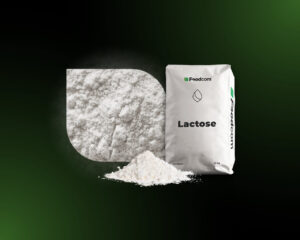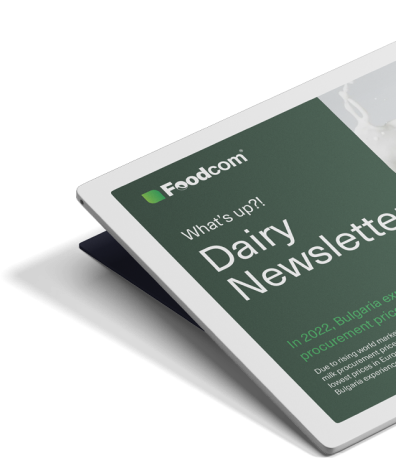- Prices of powders and cheeses are falling, and weak demand from Asia and suspended purchases in Q3 are further weakening the market.
- The liquid segment is intensifying, with a sharp increase in cream and SMC prices and limited availability of raw milk.
- Global uncertainty is growing, mainly due to weakening Chinese imports and Fonterra’s cautious forecasts for the new season.
- Changes in whey production and rising SWC prices are pushing standard whey powder out of the market, which may limit its availability.
Welcome Partners!
Welcome back to our newsletter!
While the prices of powders, such as SMP, and cheeses, such as mozzarella and cheddar, remain under pressure, the liquid segment is shrinking rapidly, with cream and skimmed milk concentrate (SMC) prices rising sharply. Meanwhile, global uncertainty is growing as demand for dairy products in China weakens and Fonterra signals a cautious price outlook. Get the full picture – read about product trends, price dynamics and key international news shaping today’s dairy market.
Scroll down for detailed market data and forecasts.
Milk powder
The European SMP market remains under clear downward pressure. Food grade milk powder prices have fallen further and are trading at €2350-2400/MT FCA, with competitive demand driving some deals below €2350/MT. Producers are reporting limited interest in spot deals, as most buyers have already secured volumes for Q3 or prefer to delay further purchases in anticipation of falling prices. The latest GDT auction confirmed the weak global market, with the SMP price down 2.5% at €2350-2360/MT, reflecting the continued lack of momentum, particularly in Asia.
The market for skimmed milk powder (SMP) for feed purposes is following a similar trend. Custom batches of the product, sold in bulk for the Dutch market, reached prices of €2350-2400/MT DAP, reflecting the deterioration in market sentiment.
Cheese
The European cheese market is adjusting to the slowdown in demand and increased availability as the seasonal peak in milk production continues to affect supply. Gouda cheese prices have fallen and now stand at €4250-4300/MT as buyers have largely met their short-term needs. With a moderate increase in stocks at some producers and limited interest in the spot market, market sentiment remains weak. The main sellers in the current market are producers outside the Netherlands and Belgium, and Dutch-origin products continue to have a relatively better position.
Mozzarella continues to be subject to downward pressure on prices. Spot offers are around €4150-4200/MT as stock levels remain high and buyers show limited interest in volumes for July. Although consumption remains fairly good, the lack of fresh demand and competitive prices in the US are adding pressure on European sellers. Cheddar cheese prices in Europe have also declined slightly, now reaching around €4600-4650/MT EXW, as Ireland and the UK face ample supply and weaker exports due to currency issues. The emmental cheese price remains stable at €5100-5150/MT, although the market is quiet with most of the Q3 demand already covered and limited new offers.
Fats
The European butter market is showing some signs of weakening despite the limited availability of raw milk. Butter block prices from producers are in the €7300-7400/MT range, with traders offering Irish-sourced product at more competitive prices of around €7150-7200/MT. Buying interest is cautious and the recent high price of cream has prevented a sharp fall in butter prices, even though market fundamentals have weakened. Polish butter is selling in the range of EUR 7250-7300/MT.
Market freefree milk fat remains stable, with no significant changes recorded.
Fluids
The European market for liquid dairy products is showing clear signs of tightening, driven by reduced milk intake in key production regions.
Cream prices have increased significantly, reflecting the seasonal decline in milk fat content and limited availability. Prices currently stand at €8800-9000/MT, placing them at or above butter equivalents. These dynamics may support butter prices in the short term, although demand remains selective. The fat market is being closely watched, as potential price adjustments in the coming weeks will largely depend on milk intake and developments in the liquid dairy segment.
In the SMC market, prices have risen sharply, especially for products of German origin, which are trading at EUR 2100-2200/MT FCA. Products of French origin remain slightly cheaper, costing EUR 1700-1900/MT, but overall availability is decreasing. The combination of stable liquid dairy markets and high raw milk prices is increasing cost pressures on processors, which could affect other dairy categories in the coming weeks.
Raw milk prices in key European producing regions have exceeded €600/MT and are on an upward trend, reflecting limited raw material availability and seasonally lower yields. This situation is putting increasing cost pressure on processors.
Whey powder
The European whey powder market remains under pressure, with food and feed prices showing no signs of recovery. Prices for sweet whey powder(SWP) sold in bulk for feed production remain stable at around €800/MT, reflecting a stagnant market. Wholesale bids in the Netherlands are EUR 800-850/MT, while talks for Q4 deliveries indicate a slight potential for an increase, with buyers offering EUR 850/MT and sellers demanding a price closer to EUR 900/MT DAP. The market remains cautious, with overall activity hampered by weak export demand, particularly from Asia.
Sweet whey powder (SWP) for food use continues to reflect weak sentiment, with current market prices in the €1,000-1050/MT range. Despite stable cheese production supporting raw material availability, the lack of international demand is limiting price increases.
Meanwhile, sweet whey concentrate(SWC) prices have increased significantly, with current offers around EUR 700-750/MT FCA. This price situation is making the production of plain sweet whey powder less attractive for many producers, who are instead focusing on higher-value whey protein concentrates(WPC). This structural shift in production may further reduce the availability of standard whey powder in the coming months.
What’s new?
New Zealand
Fonterra has provided a cautious but broad milk price forecast for the 2024-2025 season, estimating a price of around NZD 8 per kilogram of milk solids, with potential fluctuations between NZD 7 and NZD 8.75. This is lower than most bank forecasts, which indicate a range between NZD 8.2 and 8.5. The company’s conservative approach is due to the continued stagnation in global demand, particularly from China, and the delicate balance in dairy markets such as cheese and milk powder, where prices remain volatile. Fonterra and market analysts point to a growing risk of falling prices due to the potential for increased supply coupled with slowing imports, which could put pressure on producer margins and calls for caution in business planning.
China
China’s demand for imported dairy products is showing clear signs of slowing, creating uncertainty among global exporters who have long relied on the country as a key growth market. The economic slowdown, increased domestic milk production and changing consumer habits are all contributing to a reduction in imports of products such as whole milk powder and UHT milk. At the same time, China’s focus on strengthening its own dairy sector is changing market dynamics, making it difficult for international suppliers to maintain their position. While some see the potential for a future recovery linked to policies to boost birth rates and encourage consumption, for now exporters face a more competitive and less predictable environment.
World
Dairy farmers are turning to magnesium supplements as a cost-effective strategy to combat heat stress in cattle. This essential mineral aids muscle relaxation and nervous system function, helping cows to better regulate body temperature during hot weather. By supplementing feed, especially in potassium-rich pastures, or choosing bioavailable forms such as well-processed magnesium oxide, producers can safeguard milk production, fertility and overall herd wellbeing. With increasing temperature spikes due to climate change, increasing magnesium intake is a practical nutritional tool to support animal immunity.
![Summary of the dairy market situation – key price developments [274th Edition of the DAIRY Newsletter] Summary of the dairy market situation – key price developments [274th Edition of the DAIRY Newsletter]](https://foodcom.pl/wp-content/uploads/2023/08/Foodcom_Dairy_Newsletter-1520x760.jpg)






